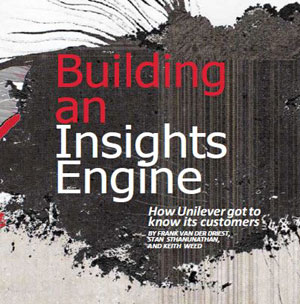The other day I was chatting with a colleague who consistently used the word "insights" to refer to what I might have called "findings". To my mind a finding is useful, an insight is transformational. And in today’s world of slow growth and big data I think we have plenty of findings, but what we really need are insights that lead to action.

I was reminded of this conversation when reading September’s Harvard Business Review cover article: "Building an Insights Engine – How Unilever got to know its customers". The article is written by Kantar Vermeer’s Frank van den Driest and Unilever’s Stan Sthanunathan and Keith Weed and highlights the ten key characteristics required to create customer-centricity and drive business growth. In the article the authors state, “At Unilever, (Consumer and Market Insights’) prominently communicated mission is 'to inspire and provoke to enable transformational action.' Note that the word 'insight' is missing — intentionally. That’s because insights merely provide a means to the desired end: action that drives business growth.”
To me the most important word in the mission is “transformational” because otherwise you are looking at incremental improvement. And that to me is the part of the difference between an insight and a finding. An insight transforms your actions while a finding merely guides them. It is not an insight to realise that men increasingly use cosmetics. Used properly the knowledge that the men that do use cosmetics feel uncomfortable navigating a physical store to find the men’s section could be, provided action is taken to alleviate that discomfort in a way that encourages more sales.
Today every company has access to data and as van den Driest, Sthanunathan and Weed note,
“What matters now is not so much the quantity of data a firm can amass but its ability to connect the dots and extract value from the information.”
The Harvard Business Review article goes on to review many of the different ways that Unilever’s CMI team are using technology to close the gap between data and insights but, ultimately, that gap is closed by someone recognising what might be done differently, more productively, more profitably as a result of looking at data. Technology can help in that process but it takes an understanding of the business and brand at large to recognise the real opportunities for change and turning a finding into an insight, into action.
With that in mind, it should come as no surprise that Insights2020, the foundational research on which the Harvard Business Review article is based, found that 79 percent of insights functions at overperforming companies participated in strategic decision-making at all levels of the organisation, compared with just 47 percent at underperforming companies. You have to be involved in the conversation if you are going to influence the outcome.
You can read "Building an Insights Engine" here.